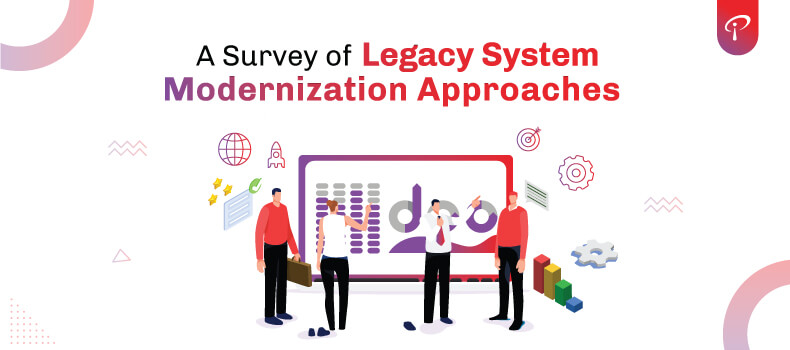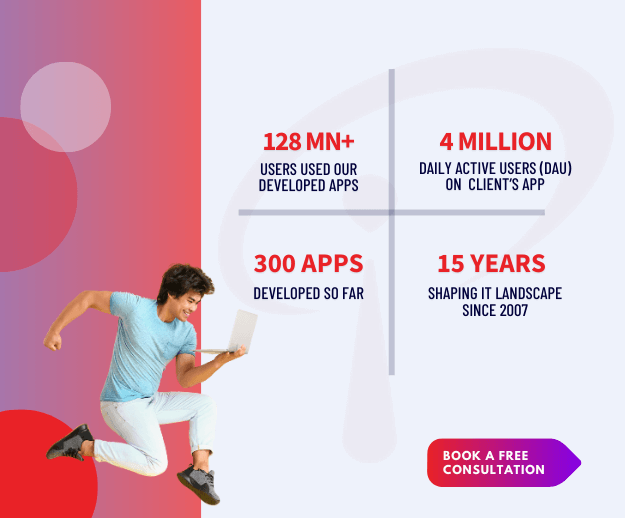Jun
24
A Survey of Legacy System Modernization Approaches

Similarly, legacy systems are being taken over with new approaches & new strategies to upgrade them once they reach their limits.
As we explore innovative ways, like social media metrics, mobile apps, data-based insights, AI/ML- relying on rigid infrastructures is an obstacle.
This is the time for companies to act. By leveraging modern tools & technologies, companies can access new opportunities, streamline core processes & achieve greater business goals through scalability.
Legacy systems, the aging infrastructure systems we know about, lose their ability to serve the business once termed as ‘legacy’. These systems are built using tightly coupled technology, often running on software & hardware that companies own, manage, and support.
Thus, they’re built around a specific company’s investments, and working.
While being functional, these systems can affect your systems severely. Here’s why:
Legacy systems can be expensive to maintain, with higher possibilities of vendor lock-in traps.
The right structure, the way they are built on right infrastructure, hinders one’s ability to adapt the systems & leveraging new technologies to sustain innovation.
The bottom line is that legacy systems have a higher potential of going against the highly evolving markets. Companies must analyze & explore different approaches to tackle this new challenge.
What is
Legacy System Modernization
Legacy system modernization is a process of updating & optimizing the current legacy systems to meet current business needs. The approach of modernizing these systems would certainly differ between companies.
However, with the rise of new systems & technologies, companies are feeling the pressure to adapt to new changes, needs and advancements.
Here’s a brief in the ways legacy system modernization benefits the business:
Modernizing legacy systems can help streamline core processes, making it to be smoother and faster.
Through legacy system modernization, businesses leverage the possibilities of cutting-edge technologies that bring forth innovation & improve customer stakes.
Systems that have been modernized can easily connect & share data with other technologies, making the systems more unified.
Often, businesses are stuck with outdated systems which disrupt & the fear of upgrading these systems. Businesses must outright acknowledge the issues these systems can bring forth.
The reality still stands that clinging to these old systems will leave companies vulnerable, owing to the security risks, undermined efficiency & limited ability to make accurate analyses.
The process of legacy system modernization has evolved beyond just updating when required. Now, it pays attention to the unique digital requirements of businesses.
This allows businesses an added layer of consideration while choosing from multiple approaches. Businesses can avail:
Upgraded IT infrastructure & functionalities to establish a stronger foundation.
Integrated newer technologies & functionalities to facilitate new possibilities.
Additional benefits of developing deep customer relationships to provide exceptional service.
Now, we understand how legacy system modernization is changing with newer technologies, let’s try to explore the different modernization approaches now!
Legacy System Modernization Approaches
This powerful modernization approach lets companies migrate their existing systems who a cloud-based ecosystem without expansive code changes.
Think of it like rearranging the furniture around the house.
Here’s why this approach is popular:
- 1. Fast & efficient processes
This approach allows the modernization process to have as little disruption as possible on other systems. This is because it takes much less time to employ this approach. - 2. Cloud Benefits Delivered
This approach lets businesses reap the benefits of cloud computing: scalability, expansion & seamless integration. These benefits can be availed without even a complete system overhaul. - 3. Reduced Reliance on Hardware
Such an approach lets every system capture a space in the World Wide Web. This allows businesses to let go of expensive & unmaintainable systems, making room for additional flexibility.
Although there exist some minor code changes or database modifications here & there, the approach offers a smooth transition of multiple applications.
This approach includes developers rewriting the existing legacy code & building it anew. This process has two ways to function: manual & automated.
Manual efforts let dedicated developers offer complete control over the new system. However, it can take a significant time frame to achieve the required results.
Now, there exist automated tools to rewrite the code, accelerating the entire process.
Regardless of the path chosen, rewriting offers a fresh start for companies to break free of the tried & tested moulds.
For many companies, directly replacing legacy systems with commercial solutions can be implemented effectively.
These off-the-rack solutions let businesses avail themselves of pre-built functionalities & workflows that integrate smoothly with current systems.
Such solutions carry readily available features, security updates & compliance capabilities. Additionally, it lets companies to future-proof their systems with the use of newer technologies.
Even when completely modernizing a legacy system is preferable, let’s explore an approach where the companies tend to retain them.
This happens due to:
- 1. Systems being a perfect fit
Current systems are built for delivering the exact functionality a business needs. - 2. User Comfort
Many stakeholders, such as all the employees, including the C-suite level associates, are already comfortable using a set system. - 3. Complexities in Integration
Choosing a complete overhaul while modernizing legacy systems disrupts the ongoing integrations with existing processes. - 4. Limited Use
This refers to when the legacy system is only utilized whilst auditing or any compliance related reasons.
In a case like this, companies have the options to archive the system for a low-cost solution or customize it heavily to just generate reports from it.
Many businesses have started relying on a DevOps solution to facilitate the process of legacy system modernization. This lets businesses constantly integrate new or updated code into a single codebase.
This results in streamlined processes to build & deploy error-free code later and faster.
However, employing this solution require 3 prerequisites to be set up:
- – A unified development landscape
- – A single repository for all code
- – Automated Testing
Having the DevOps approach allows the implementation of any changes to be done in shorter cycles, making room for agility.
The high costs included in managing legacy systems are trumped by the costs & efforts it takes to handle all the big data businesses receive.
This heavily hinders a business’s ability to integrate new gen tech like cloud computing, big data & mobile applications.
Some businesses, thus, choose to migrate their legacy systems’ data to modern forms of databases. Businesses gain easy access of data along with scalability, agility, and flexibility while managing their newly formatted data.
APIs come to a developer’s rescue with them enabling a smooth integration with varied platforms & applications.
An API functions like a messenger between apps, seamlessly communicating & sharing data.
Through adoption of APIs, businesses can now clear the path for a highly customizable enterprise architecture. This flexibility lets them create new applications like building blocks.
This method future-proofs businesses by allowing them to interact with and sustain new gen technology integrations.
Legacy system modernization isn’t a one-size-fits-all solution. Employing the best approach relies on many factors, including current system’s specifications, desirable integrations, and budget.
Some systems may have to be completely overhauled, while some may just need tweaks.
We offer comprehensive legacy system modernization services that help you create a custom plan for your establishment. We also offer legacy app modernization, legacy software modernization, mainframe legacy modernization, IT Legacy Modernization, Cloud Legacy Modernization, legacy data modernization.
Our team of experts will feel like an in-house extension to yours. By figuring out your needs, we formulate our way of workings.
Let us help you harness the full potential of your systems. Click here for more!





















































